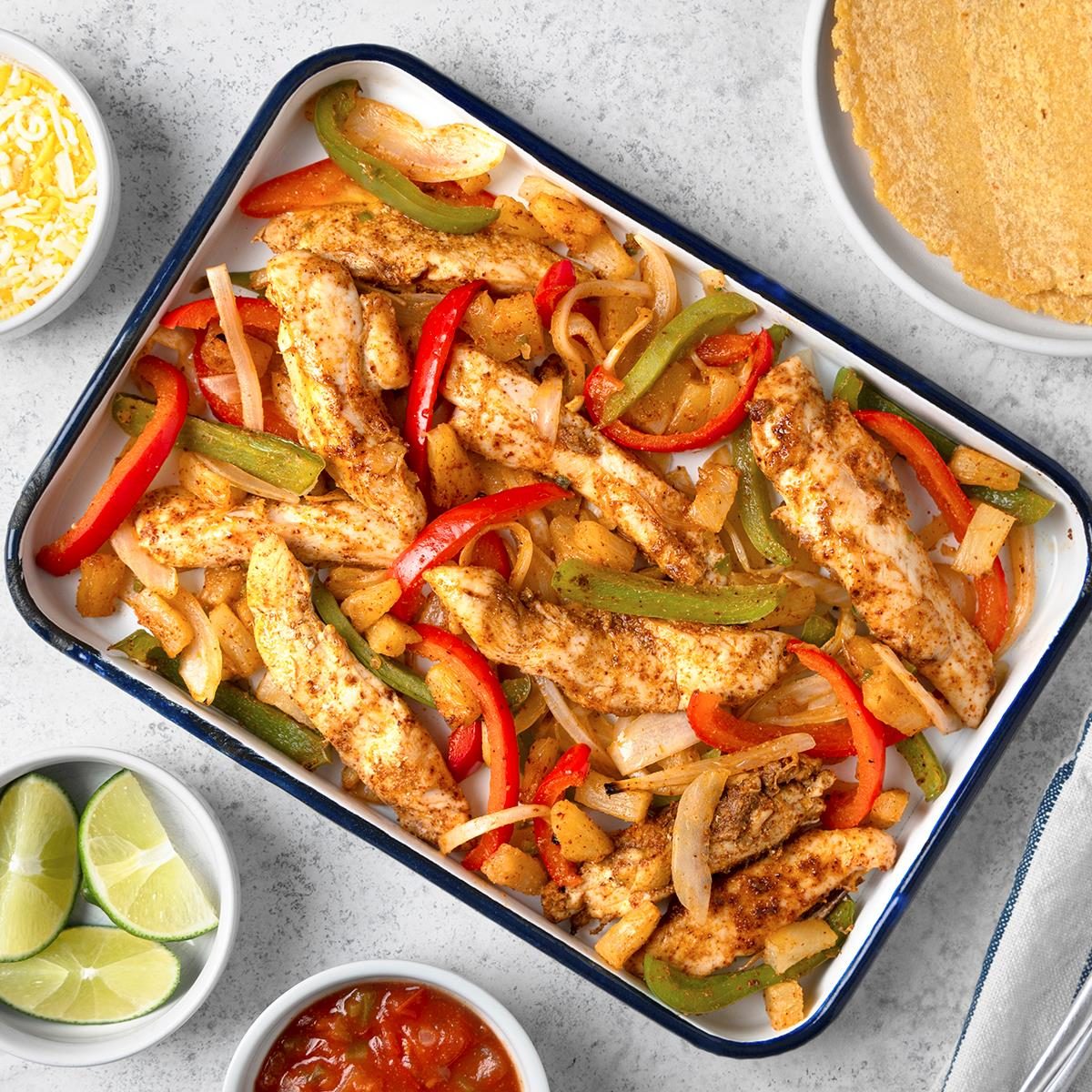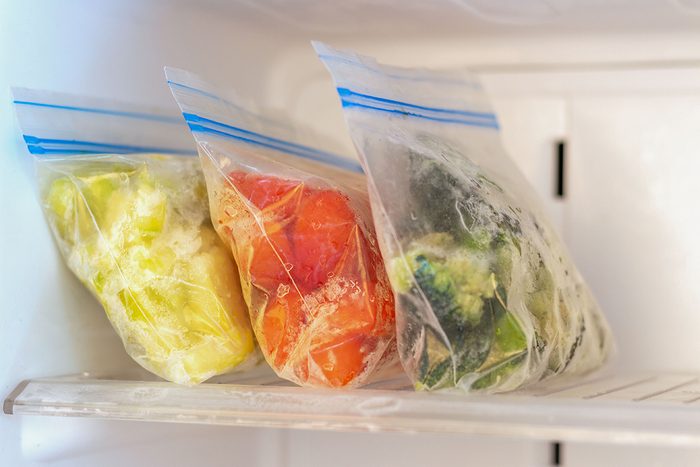From our kitchens to yours.

10 Secrets of People Who Always Have Dinner on the Table in 30 Minutes


1. Organize Your Fridge
Organizing doesn’t mean that you need to go out and spend a lot of money on aesthetically pleasing containers (although if you want to, go ahead!). It’s as simple as putting a basic system in place. “I find that if there’s too much in there, ingredients and leftovers get lost and sometimes wasted,” says Test Kitchen manager Catherine Ward. She has it down to a science: “Fruits, greens and veggies on the bottom shelf, meats and cheeses on one side of the middle shelf and leftovers on the other. Top shelf is yogurt, eggs, pickled items and Asian sauces and condiments. All other condiments and butter are on the door.”
You can take it one step further and make sure containers have their label facing forward. It makes it so much easier to see everything at a glance. This way you’re not digging around to make sure you grabbed the plain yogurt instead of the vanilla, for example. Plus, when everything has a designated spot, you can quickly see what you’re running low on, or what you need to use up.

2. Shop Smart
Going to the grocery store without a plan is like throwing a bunch of random clothing items in a suitcase and hoping you have some good outfits to wear on vacation. You’ll probably get by just fine, but chances are you’ll be wasting precious cargo space lugging around a bunch of clothes that you never wear. Imagine showing up for a beach vacation with a ton of sweatshirts!
It’s the same with buying food. Just 10 to 15 minutes of planning can save you energy and money while shopping. These are a few ways that our staff streamline the grocery-shopping process:
- “I meal plan on Saturdays. I look at my calendar for the upcoming week and note which days I have time to make dinner and which days need something quick. This method allows me to look forward to the days when I have time to cook, but also helps me stay realistic about busier days.” — Emily Parulski, newsletter editor
- “I utilize grocery pick-up through our local grocery store. Being able to do my grocery shopping online has been a game changer for me.” — Ellen Crowley, culinary producer
- “Unless I’m making specific dish, I mentally plan a week’s worth of dinners based on what we have. We don’t shop daily, so I have a packed pantry, lots of fresh veggies in the fridge and I’m a big fan of my freezer. I scan what we have, plan a few days of dinners at a time and defrost what we need.” — Lesley Balla, associate food editor

3. Pick a Planning Day
Meal planning is certainly not a new concept, but I think a lot of home cooks forget just how flexible you can be with it. Everyone’s schedules are so different, and sometimes Sunday is just too busy to handle all of those household chores. The most popular meal prep days for our staff are actually Monday and Saturday!
Figure out the schedule that works for you. I like to split my meal planning session and my grocery shopping into two different days, otherwise I get overwhelmed. On Friday mornings I like to save recipes and make a list for the coming week, then I grocery shop on Sunday. Since I’m usually an overambitious planner, I like the buffer day between planning and shopping so that I have a chance to be more realistic about my grocery needs.
My Google calendar isn’t just a scheduling tool; I love to use it as a grocery list, too. I block out two hours on Sunday for grocery shopping, and then I write my grocery list in the calendar event itself. If I’m out shopping and I can’t remember if I have any limes, for example, I can look at my calendar and see if I bought them the previous week.

4. Embrace Ingredient Prep
The game-changer in getting meals on the table quickly isn’t preparing seven dinners on Sunday night (although, if you have the energy and fridge space for that, I applaud you!). Instead of thinking of prep days as a chance to cook entire meals, use it as time to prep specific ingredients. This way, weeknight meals come together with a lot less chopping, peeling, marinating and mixing.
These are just some of the items that our staff regularly make ahead for quicker weeknight meals:
Aside from that, ingredient prep can be as simple as dicing or cubing vegetables for stir-frying and roasting. Or you can clean, dry and store berries and fresh herbs in the fridge so they’re ready to use. If I have a jar of pickled veggies and a creamy dressing in my fridge, I become invincible during the week!

5. Use Frozen Vegetables
Almost everyone on staff that I talked to had high praise for the utility of frozen vegetables. If you don’t currently have a bag of broccoli florets in your freezer, you’re missing out!
Frozen vegetables are the single most versatile ingredient to always have on hand. They can go from freezer to oven to table with remarkably little effort and time. You don’t have to thaw them before roasting them, and they still get nice and toasty in the oven. Plus, they’re almost always chopped, which saves on prep time, too.
Food writer Valerie Goodrich shares her secret to elevating the humble frozen vegetable: “After cooking the veggies, I dress them with a pinch of salt, squeeze of lemon and pat of butter to make them taste a bit more special with minimal effort.”

6. Empty the Dishwasher
Just like washing and prepping ingredients, sometimes the real time suck of cooking is all of the other stuff you have to do in tandem. Putting a meal on the table knowing you have to go back to a messy kitchen afterwards can drain all the fun out of dinnertime.
“Whenever I cook on weeknights, I always make sure the dishwasher is emptied before I start,” says Valerie. “That way, I can load the dishwasher as I cook, which makes my kitchen feel so much less chaotic and makes clean-up a breeze.”

7. Enhance Store-Bought Items
Thanks to Ina Garten, we all know that “store bought is fine.” And while she’s correct, there are a lot of ways that you can customize store-bought items for your own meals. It’s that sweet spot of making something unique and tasty without spending hours making it from scratch.
I love adding my own toppings to a frozen pizza. At a minimum, I’m shaking on some oregano, basil, garlic powder and onion powder. Fresh spinach and cremini mushrooms always seem to accumulate in my fridge, and using them as pizza toppings is a great way to make sure they don’t spoil. They also add depth of flavor and some extra nutrients to a simple frozen pizza.
Associate editor Alyssa Asaro loves to doctor a jarred pasta sauce to make it feel fancier. “I’ll add cheese, lemon, spices like garlic powder or red pepper flakes,” she says. “And sometimes I’ll even add meat.” Her favorite starting point is this spicy vodka sauce.

8. Use C.O.R.N.
If you have a few different leftover meals in your fridge, but not enough for your entire family to eat the same thing, then it’s time to use C.O.R.N. This stands for “Clean Out Refrigerator Night” and it’s what Catherine Ward swears by. “I don’t cook dinner every night but dinner is served every night. Sometimes it’s leftovers, and on those nights, we might all be eating something different.”
Saving leftovers from spoilage while also making sure you have dinner on the table is a win-win. Sure, one half of your family might be enjoying stuffed peppers while the other is finishing up a teriyaki stir-fry, but the most important thing is that everyone is together and fed!

9. Your Freezer Is Your Friend
Once you’ve fully embraced the power of your freezer, you’ll never look back. I’ve already mentioned the utility of frozen vegetables, but there’s so much potential in your freezer. Several of our staff always make double batches of soups, lasagnas and chilis, so half can be frozen for a later date.
But aside from making freezer meals, you can also batch-cook ingredients and freeze them so they’re ready to heat and go. Senior editor Lindsay Mattison is a huge proponent of cooking and freezing proteins. “These are real wins for last-minute dishes because they thaw in about 30 minutes in cold water,” she said. “Pulled pork, meatballs, smoked brisket or braised pork belly work especially well. Pulled pork can be used for everything from sandwiches to salads, rice bowls, baked potatoes, mac and cheese, tacos and nachos.”

10. The “One Thing” Principle
Every staff member I talked to always mentioned that one thing they keep on hand so that they can throw together a quick meal. Emily keeps andouille sausage on hand so she can make a quick jambalaya with a box of Zatarain’s. Lindsay keeps bean thread noodles in her pantry for quick no-cook summer dishes. Several staffers keep a block of tofu in their freezer; it defrosts easily, and freezing tofu can actually give it a chewier, “meatier” texture.
Think about the dishes that you most love to cook, or the ones that you know you can throw together at a moment’s notice. Is there a one thing element there? Making sure you always have that in your kitchen can be the difference between a stressful and peaceful weeknight meal. My one thing is a jar of pesto!




















